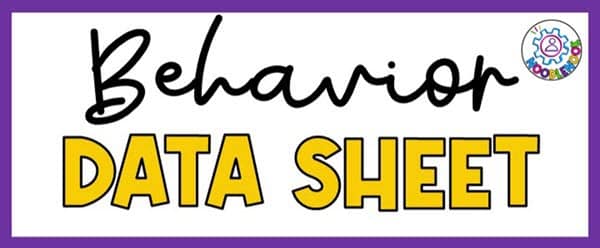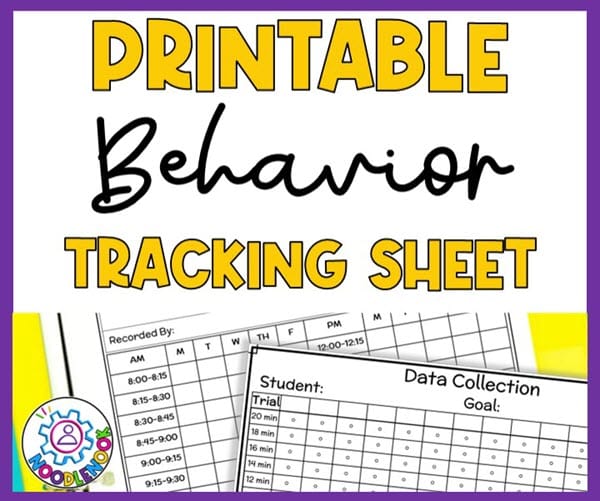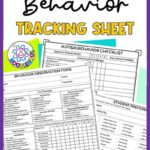As teachers, a lot of what we do is manage student behavior and reinforce positive classroom conduct. That type of classroom management is an essential cornerstone of teaching. And, when you support students with disabilities or educational plans, data collection becomes an important part of the conversation. That’s why a printable behavior tracking sheet is so important.
They are an easy way for teachers to record detailed student behavioral data. Once we have rock-solid data, we can identify areas for early intervention and track progress over time. This is all about tracking specific behaviors that are disruptive to learning and changing them into positive behavior over time. In this post, we will cover behavior data sheets and how to use them to target behavior and stop negative behavior in your classroom.
Benefits of a Printable Behavior Tracking Sheet
For a teacher, a printable behavior tracking sheet is a record of their student’s behavior. Data sheets are the best way for teachers to capture data on the fly in the classroom without disrupting instruction. I love full sheets on a clipboard since they are easy to carry and I usually have one on me anyway. Otherwise, postit notes make for great data collection tools since they are more discrete. As you track data, remember the frequency, duration, or intensity of specific negative or positive student behaviors will determine the type of data you take.
All of this data does a few distinct duties. First, this data helps you identify trends in behaviors. For most teachers, identifying these trends is the hardest part. But, without good baseline information, it becomes difficult to set specific goals. Purposeful goal setting is the second benefit as you collect data. When we make data-driven decisions, the student plans that we generate are more purposeful. This is the third benefit, sound legal documents within our IEPs. Finally, when we track behavior over time, we can better acknowledge progress with positive reinforcement of appropriate behaviors. With all these benefits it’s clear that every teacher needs a printable behavior tracking sheet set within their classroom.
Establishing Clear Behavioral Baselines
One of the benefits of using printable behavior tracking sheet documents in the classroom is that it helps us to establish clear behavioral baselines.
As we track student behavior and target change through interventions, establishing a clear, concrete behavioral baseline is a must. Once we’ve established a baseline, we have a better idea over a specific time. Or in real time if a student is actually making a change. If you ask special education teachers, they’ll confirm that having a baseline is a must so you can report on progress and change as part of a student’s IEP.
So, before interventions begin, you should track the frequency, duration, intensity, or other data points of specified behaviors. Depending on your classroom management goals (or squeakest wheel) you can track behavior for individual students or groups over set periods of time, like a week or a month.
The baseline data demonstrates current normative occurrence rates which interventions will aim to increase or decrease. Baseline data provides a starting data point against which to measure intervention impact and progress. Ongoing data collection allows continual comparison of new rates against initial baselines throughout the intervention period. That means take the data and get that baseline!
Informing Robust FBAs and BIPs
After establishing baselines, and determining the extent and intensity of a behavior, it’s time to do more. Robust behavioral records from printable behavior tracking sheet information can provide essential data to drive functional behavioral assessments (FBAs) and behavior intervention plans (BIPs). An FBA investigates behavior triggers and functions to understand root causes, while BIPs outline strategies targeting behavioral change.
In most cases, you will need more than just a set of behavior baseline data. You will also want to do a more detailed observation of the behaviors. This is because concrete behavioral records allow teachers to identify patterns signaling behavioral triggers or causes underlying inappropriate conduct. This well-done FBA makes writing a meaningful behavior plan easier. It will also help identify interventions that can address the root causes of behaviors.
Using Concrete Data to Reinforce Positive Conduct
Detailed behavior records not only help teachers identify triggers and patterns with inappropriate conduct but also serve to reinforce appropriate classroom behavior. Let’s face it, sometimes we cannot see good behavior when a student struggles with bad behavior in the classroom. When we have concrete data using printable behavior charts, we can see in numbers with a record of their students behaviors the number of times it is occurring, if there are new behaviors happening, and if you are seeing more positive behaviors over specific time periods. With all this information, we can look to strongly reinforce positive behavior in students and pay out on all those student behavior contracts!
Okay, okay… obviously we need printable behavior tracking sheet documents in our classroom. But how do we go about using them?
How to Collect Behavior Data in the Classroom
Collecting behavior data in the classroom is a systematic process crucial for understanding, addressing, and improving student behaviors. Before you begin, identify the type of data sheet that you need to use. In the digital download of behavior data sheets, there is a decision guide to help determine the best sheet for the job. From there, identify the specific behaviors you want to track. These should align with your overall intervention goals.
Next, we set out to collect some data, starting with baseline data. This can be with a single long observation session or with prolonged data collection that is embedded in classroom instruction. How you choose to collect your baseline data will depend on the age, abilities, and challenges of your students. Use a variety of methods, including frequency counts, duration recording, and intensity scales, depending on the behavior’s nature. Be observant and objective, noting the antecedents and consequences surrounding each behavior.
Then we identify targeted interventions with data-driven decisions. Since we have great baseline data, it should be easier to determine which intervention will work best given the child’s age, their needs, and their personal goals. Involve students in the process where applicable. This can be especially true for middle school and high school students. They may have challenges in specific areas and better self-awareness to participate in their goal development. Moreover, they may have some behavioral information that can help decide on interventions, like behavior contracts, daily behavior charts, or notes home.
Finally, we continue to track behavior to analyze it and make future decisions. Consistency is key with data collection, so establish a routine for getting data done. That may be daily, weekly, or based on specific events. Regularly review and analyze the collected data to identify patterns, assess intervention effectiveness, and make informed adjustments to support positive behavior change. Remember, the quality of the data collected directly influences the success of your behavior management strategies.
Start Tracking Behaviors with Ease
Now that you know how much you need a set of printable behavior tracking sheet documents in your classroom, what are you waiting for? Grab this set of data sheets today. They are easy to set up, intuitive to use, and great for print-and-go access. Printable behavior tracking sheets help teachers seamlessly improve classroom management and student self-regulation.
With student behavior data at their fingertips, teachers can reinforce positive conduct, identify and investigate problem behavior triggers, and continually track intervention effectiveness. You can get this set of printable behavior tracking sheet documents in PDF format. They are the classroom forms you need to support students, whether they have minor behavior concerns or full-blown def-con level behaviors. Get started today addressing the special needs of the students in your classroom. Click here to get yours now.
Behavior Data Sheet FAQ
What is a behavior data sheet, and why is it essential in the classroom? A behavior data sheet is a tool used to systematically collect and record information about student behaviors over a specific period of time. It is crucial in providing objective and measurable data, helping educators understand, analyze, and address various behaviors in the classroom.
How do I choose the right behavior data sheet for my students? Selecting the appropriate behavior data sheet depends on the specific behaviors you aim to track, the age and abilities of your students, and your intervention goals. You can choose from frequency, intensity, or duration data sheets. Consider using different sheets for different behaviors to ensure comprehensive data collection.
What types of behaviors can be tracked using behavior data sheets? Behavior data sheets can be tailored to track a wide range of behaviors, including positive and negative actions, academic engagement, social interactions, and adherence to specific routines. The key is to customize the data sheet to align with your behavioral objectives. With the data set mentioned above, you can use the decision matrix to decide on the best data format for you. It also provides information on how to analyze the results. In other words, it’s everything you need to track and share solid data.
How often should I collect behavior data? The frequency of data collection depends on the nature of the behavior and your intervention goals. Regular collection, whether daily, weekly, or tied to specific events, is essential for identifying patterns and assessing the effectiveness of interventions over time.
Can behavior data sheets be used for students of all ages and abilities? Yes, behavior data sheets can be adapted for students of varying ages and abilities. From simple visual charts for younger students to more detailed data tracking systems for older ones, customization ensures the tool is suitable for all learners.
What data should I include on a behavior data sheet? Include relevant information such as the date, time, antecedents (triggers), the observed behavior, consequences, and any additional notes. This comprehensive data provides a holistic view, aiding in the analysis of behavior patterns.
How can behavior data sheets support positive behavior interventions? Behavior data sheets serve as a foundation for designing effective positive behavior interventions. They offer insights into the function, frequency, and duration of behaviors, enabling educators to tailor interventions that promote positive change.
Are there digital alternatives to traditional paper behavior data sheets? Yes, digital tools and apps are available for behavior data collection, providing real-time tracking and analysis. These tools can enhance efficiency and streamline the data collection process. Your school or district may have access to these pro systems. Those providers may also offer professional development on how to implement their tracker templates.
How can I involve students in the behavior data collection process? Depending on the age and maturity of the students, consider incorporating self-monitoring strategies. Involve them in setting behavior goals, and encourage reflection on their own actions to foster a sense of responsibility. Also, include students as you customize the interventions. Things like token boards and end of the week reports can benefit from student involvement at the start of implementation.
What should I do if the collected behavior data indicates interventions are ineffective? If data analysis suggests that interventions are not yielding the desired results, it may be time to reevaluate the chosen strategies. Consult with colleagues, specialists, or behavioral experts for additional insights and consider adjusting the intervention plan accordingly.










